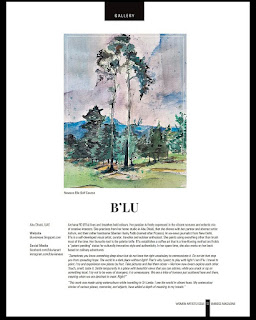[Published: November 12, 2008 Gulf News]
A fiercely independent lot, the Bavarians have always maintained a strong national identity. I enjoyed their hospitality in the summer of 2008, as I cruised the Rhine travelling south through Germany.
From the valley we went down the Romantic Road of Rothenburg to reach Munich, the capital of Bavaria. The Rhine valley and the road to Bavaria offer a spectacular view of the region's vineyards, castles and ancient churches. And in case you think beer is all the Bavarians can brew, a taste of their white Riesling (dry, white wine), is a must to dispel this myth.
Day two in Munich saw us exploring Marienplatz and after a hearty Bavarian breakfast walking the quaint cobbled stoned pavements was just what the doctor ordered. Once you reach the Marienplatz everything you need is within strolling distance.
The Old and New Town Halls look down on the golden Mariensoul. Saint Peter's church, just off Marienplatz, is the oldest church in Munich, and for a fantastic view of the city, you could climb the bell frey tower. There are local artists selling the city panorama in water and oil from the top of the church.
The Englischer Garten or English Garden is a large park in the heart of the city and is famous for beer gardens and nude sunbathing. Moving on from nature, in all her glory, to science and technology and a visit to the Deutsches Museum. It is one of the famous technology and science museums in the world. Eight floors of displays from boats to telescopes to robots; which is a great stop over for scientists or people who love machines.
Read on Bavarian cuisine here
A fiercely independent lot, the Bavarians have always maintained a strong national identity. I enjoyed their hospitality in the summer of 2008, as I cruised the Rhine travelling south through Germany.
From the valley we went down the Romantic Road of Rothenburg to reach Munich, the capital of Bavaria. The Rhine valley and the road to Bavaria offer a spectacular view of the region's vineyards, castles and ancient churches. And in case you think beer is all the Bavarians can brew, a taste of their white Riesling (dry, white wine), is a must to dispel this myth.
While the countryside is a romantic mix of lush vineyards and fairytale castles across the valley and the countrysides you can also see train-lines and roads running parallel to the river, transporting industrial goods to the cities and ship yards almost throughout the day. There is no escaping the influence of the Industrial Revolution.
 |
| A statue of Lorelei watches over the treacherous stretch of water near Sankt Goarshausen |
But aside from the purpose of modern living there is always space for legends, and the Lorelei rock is evidence of that. The rock on the eastern bank of the Rhine near Saint Goarshausen rises up almost 132 metres above the water-level. Downstream the river is at its narrowest and deepest point, so the Middle Rhine at this juncture is difficult to navigate. This is also the narrowest part of the river between Switzerland and the North Sea and is infamous for its strong currents. The rocks in the area have caused many boats to capsize. The fable goes that a siren called Lorelei bewitched the hearts of the sailors and when they looked up to the rock, their boats crashed and they sank to their doom.
The main tourist attractions in Munich are Marienplatz, Glockenspiel, Saint Peter's church, Englischer Garten, Deutches Museum and BMW Museum. Unfortunately, we couldn't catch a glimpse of the Glockenspiel, known to chime with life-sized statues rotating in a mock dance, as it was being renovated. Instead we went to the café opposite, not surprisingly called as Café Glockenspiel, where we enjoyed some Bretzel and Bratwurst.
The main tourist attractions in Munich are Marienplatz, Glockenspiel, Saint Peter's church, Englischer Garten, Deutches Museum and BMW Museum. Unfortunately, we couldn't catch a glimpse of the Glockenspiel, known to chime with life-sized statues rotating in a mock dance, as it was being renovated. Instead we went to the café opposite, not surprisingly called as Café Glockenspiel, where we enjoyed some Bretzel and Bratwurst.
Day two in Munich saw us exploring Marienplatz and after a hearty Bavarian breakfast walking the quaint cobbled stoned pavements was just what the doctor ordered. Once you reach the Marienplatz everything you need is within strolling distance.
The Old and New Town Halls look down on the golden Mariensoul. Saint Peter's church, just off Marienplatz, is the oldest church in Munich, and for a fantastic view of the city, you could climb the bell frey tower. There are local artists selling the city panorama in water and oil from the top of the church.
The Englischer Garten or English Garden is a large park in the heart of the city and is famous for beer gardens and nude sunbathing. Moving on from nature, in all her glory, to science and technology and a visit to the Deutsches Museum. It is one of the famous technology and science museums in the world. Eight floors of displays from boats to telescopes to robots; which is a great stop over for scientists or people who love machines.
 |
Idyllic countryside Bavarian cottage. Picture clicked to paint on the go.
|
The evening was spent outdoors, soaking up the last rays of the sun and the beautiful vistas of white houses outlined in dark wood. And just before night descended in her inky blackness, the sky came alive with the vibrant orange and majestic purple hues of another day gone by.
Read on Bavarian cuisine here




